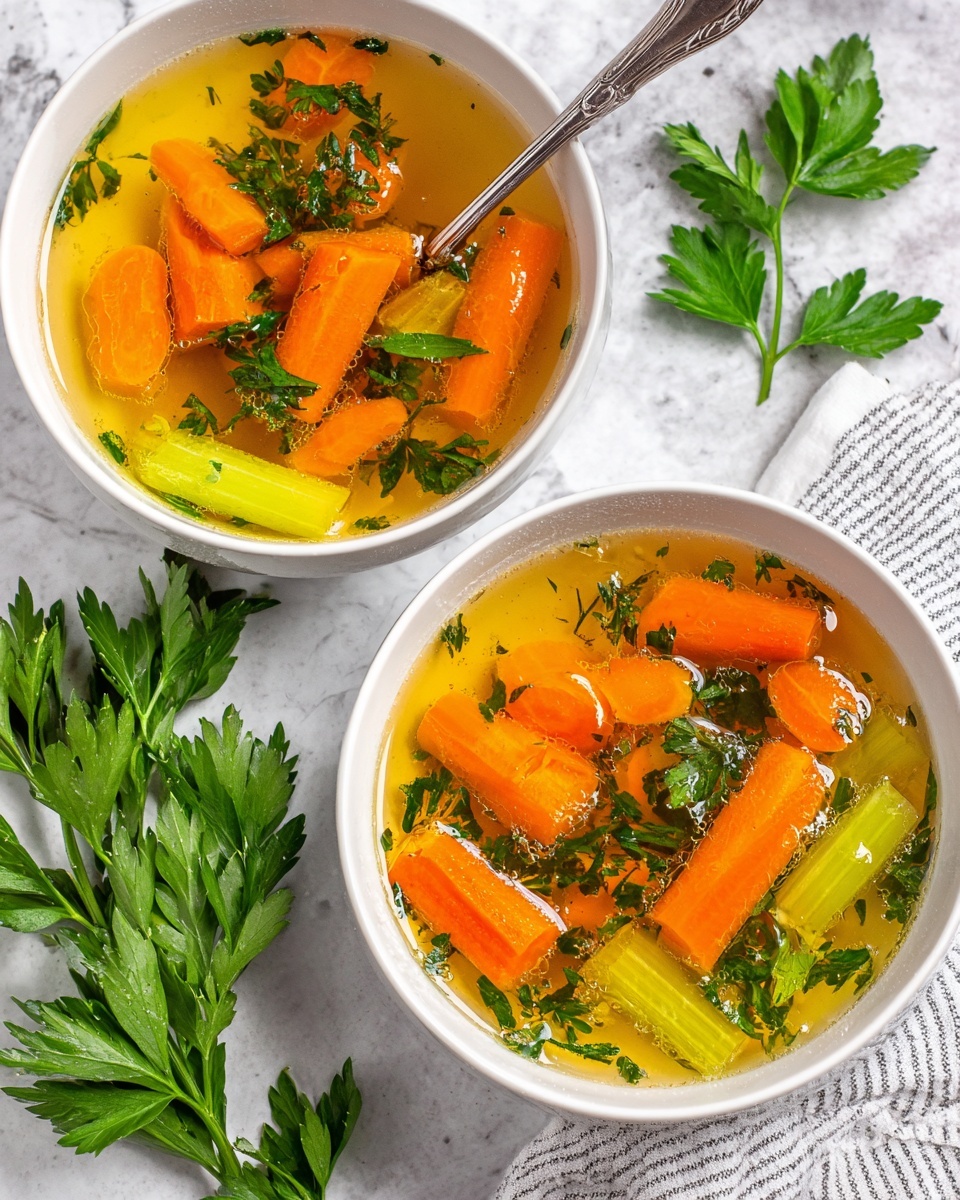If you’re craving something that feels like a warm hug on a chilly day while nourishing your body from the inside out, the Cleansing Winter Vegetable Miso Soup Recipe should definitely be your next kitchen adventure. This vibrant, soothing soup brings together the best of seasonal winter vegetables and the deep, savory umami of miso, creating a bowl that’s both cleansing and comforting. Light yet deeply satisfying, it’s perfect not only for cold days but also when you want to gently detox and give your immune system a natural boost without any heaviness or guilt.

Ingredients You’ll Need
Every ingredient in this soup is simple but essential, each contributing layers of flavor, texture, and color that make this dish shine. From the earthiness of mushrooms to the subtle spice of ginger, each element plays a star role in bringing this soup to life.
- 6 cups water or low-sodium vegetable broth: Provides a gentle, hydrating base that carries all the flavors beautifully.
- 3 tablespoons white or yellow miso paste: Adds the soulful umami and probiotic goodness that defines this soup.
- 1 tablespoon grated fresh ginger: Gives a fresh, warming zing that brightens the broth.
- 2 garlic cloves (minced): Infuses the soup with aromatic depth and a subtle kick.
- 1 tablespoon tamari or low-sodium soy sauce: Boosts the savory notes while keeping saltiness in check.
- 1 tablespoon sesame oil: Brings a lovely nutty richness and aroma.
- 1 cup chopped napa cabbage or green cabbage: Adds sweetness and tender crunch.
- 1 cup sliced shiitake or cremini mushrooms: Offers earthy texture and meaty flavor.
- 1 medium carrot (julienned or thinly sliced): Introduces a hint of natural sweetness and vivid color.
- 1 small daikon radish (peeled and sliced): Provides gentle peppery undertones and crispness.
- 1 small zucchini (thinly sliced): A soft, mild vegetable that rounds out the texture profile.
- 2 green onions (sliced): Adds a fresh bite and vibrant green pops.
- 1 cup baby spinach or kale: Delivers leafy nutrition and a bright green contrast.
- Optional: tofu cubes or a pinch of red pepper flakes for heat: For a protein boost or a little fiery kick, customize as you like.
How to Make Cleansing Winter Vegetable Miso Soup Recipe
Step 1: Sauté the Aromatics
Start by heating the sesame oil in a large pot over medium heat. Adding the minced garlic and grated ginger first allows their flavors to bloom and infuse the oil, creating a fragrant foundation that will carry all your vegetables.
Step 2: Cook the Vegetables
Next, toss in the sliced mushrooms, carrots, daikon, and zucchini. Cooking them for 3 to 4 minutes softens their texture just enough while starting to meld their natural sweetness and earthiness into the base.
Step 3: Simmer the Broth
Pour in the water or vegetable broth, bringing everything to a gentle simmer. Add the chopped cabbage and let it cook for 5 to 7 minutes—this keeps the vegetables tender but crisp, which is essential for that perfect winter soup mouthfeel.
Step 4: Stir in the Miso
Turn off the heat before incorporating the miso paste. Dissolve the miso first in a small bowl with some hot broth to avoid clumps, then stir it back into your pot. This crucial step preserves the beneficial probiotics in miso and ensures your soup stays light and healthful.
Step 5: Final Seasoning and Greens
Add the tamari or soy sauce, then taste and adjust as needed to find a perfect savory balance. Just before serving, fold in the baby spinach or kale and green onions—they add fresh color and a little crunch, highlighting the soup’s bright, cleansing qualities. If you’re adding tofu cubes, gently stir them in now to warm through without breaking apart.
How to Serve Cleansing Winter Vegetable Miso Soup Recipe

Garnishes
A sprinkle of toasted sesame seeds or finely sliced green onions can add beautiful texture and make each bowl feel extra special. For a little heat, scattered red pepper flakes lift the comforting flavors with a lively finish.
Side Dishes
Pair this soup with a warm bowl of steamed rice or some chewy soba noodles tossed lightly with sesame oil for a fuller meal. Simple pickled vegetables or a crunchy seaweed salad also make excellent companions, complementing the clean flavors while adding exciting textures.
Creative Ways to Present
Serve the soup in rustic bowls for a cozy, homey vibe or in elegant Japanese-style lacquerware to impress guests at your next dinner party. Adding edible flowers or fresh herbs as finishing touches turns every serving into a feast for the eyes as well as the palate.
Make Ahead and Storage
Storing Leftovers
This soup keeps beautifully in the refrigerator for up to 3 days. To maintain the vibrant flavor and preserve the gentle texture of the greens, store the soup and fresh greens separately if possible, adding the greens fresh when reheating.
Freezing
While the broth and vegetables freeze well, the fresh leafy greens and tofu may alter in texture after thawing. Freeze the base soup without the greens and add them freshly when you reheat the soup for best results.
Reheating
Reheat gently on the stovetop over low to medium heat. Avoid boiling to protect the miso’s probiotics. Add in any fresh greens or tofu cubes toward the end of warming so they retain their bright colors and tender texture.
FAQs
Can I use other vegetables in this soup?
Absolutely! The Cleansing Winter Vegetable Miso Soup Recipe is very forgiving. You can swap in other seasonal or favorite vegetables like bok choy, broccoli, or sweet potato. Just adjust cooking times accordingly so everything stays tender-crisp.
What kind of miso paste works best?
White or yellow miso paste is ideal for this soup because they are mild and sweet, complementing the delicate winter vegetables. Red miso is stronger and saltier, which can overpower the soup’s gentle flavors.
Is this soup suitable for a gluten-free diet?
Yes, when you use gluten-free tamari or soy sauce and double-check your miso paste, this soup fits perfectly into a gluten-free lifestyle. It’s naturally vegan and packed with nutrients too.
How can I add more protein to the soup?
Tofu cubes are a fantastic, easy addition for protein. You can also add cooked edamame or a handful of cooked quinoa for extra texture and nourishment while keeping the soup light.
Why shouldn’t I boil the soup after adding miso?
Boiling miso destroys the beneficial probiotics that support gut health and alters the soup’s delicate flavors. Stirring it in off heat ensures you get all the healing benefits and that wonderful umami taste.
Final Thoughts
There’s something truly special about the Cleansing Winter Vegetable Miso Soup Recipe that feels like both a treat and a tonic. Whether you’re warming up on a crisp day, supporting your body’s natural detox, or simply enjoying a moment of mindful cooking, this soup delivers pure comfort and nourishment in every spoonful. Grab your pot and ingredients, and let this easy, delicious recipe become your new winter favorite.
Print
Cleansing Winter Vegetable Miso Soup Recipe
- Prep Time: 15 minutes
- Cook Time: 20 minutes
- Total Time: 35 minutes
- Yield: 4 servings
- Category: Soup
- Method: Stovetop
- Cuisine: Japanese-Inspired
- Diet: Vegan, Gluten Free
Description
Cleansing Winter Vegetable Miso Soup is a nourishing and warming Japanese-inspired broth packed with seasonal vegetables and gut-friendly miso paste. This light yet satisfying soup is perfect for cold days, gentle detoxing, or when you need a comforting immune boost without feeling heavy. It features a flavorful blend of fresh ginger, garlic, shiitake mushrooms, napa cabbage, and leafy greens, gently simmered to preserve nutrients and taste.
Ingredients
Broth and Base
- 6 cups water or low-sodium vegetable broth
- 3 tablespoons white or yellow miso paste
- 1 tablespoon tamari or low-sodium soy sauce
- 1 tablespoon sesame oil
Aromatics
- 1 tablespoon grated fresh ginger
- 2 garlic cloves, minced
Vegetables
- 1 cup chopped napa cabbage or green cabbage
- 1 cup sliced shiitake or cremini mushrooms
- 1 medium carrot, julienned or thinly sliced
- 1 small daikon radish, peeled and sliced
- 1 small zucchini, thinly sliced
- 2 green onions, sliced
- 1 cup baby spinach or kale
Optional
- Tofu cubes
- A pinch of red pepper flakes for heat
Instructions
- Heat Aromatics: In a large pot, heat the sesame oil over medium heat. Add the minced garlic and grated fresh ginger, sautéing for 1 to 2 minutes until fragrant but not browned to develop a flavorful base.
- Cook Vegetables: Add the sliced mushrooms, carrots, daikon radish, and zucchini to the pot. Cook for 3 to 4 minutes, stirring occasionally, allowing the vegetables to soften slightly while maintaining their texture.
- Simmer Broth: Pour in the water or vegetable broth and bring the mixture to a gentle simmer. Stir in the chopped cabbage and let cook for another 5 to 7 minutes until all vegetables are tender yet still retain some bite.
- Add Miso Paste: Turn off the heat and dissolve the miso paste in a small amount of hot broth taken from the pot to prevent clumping. Stir the dissolved miso back into the soup gently, ensuring it is fully incorporated without boiling.
- Season Soup: Stir in the tamari or soy sauce. Taste and adjust seasoning if needed. This step ensures balanced umami flavors without overpowering saltiness.
- Finish with Greens and Tofu: Just before serving, add the baby spinach or kale and sliced green onions to keep them bright, fresh, and nutrient-rich. If using, gently stir in tofu cubes at this stage to warm without breaking apart.
Notes
- Do not boil the soup after adding miso paste to preserve its probiotics and delicate flavors.
- Add cooked soba noodles or rice to make the soup more filling and turn it into a hearty meal.
- Miso paste saltiness can vary between brands; adjust amount of tamari or soy sauce accordingly to taste.








